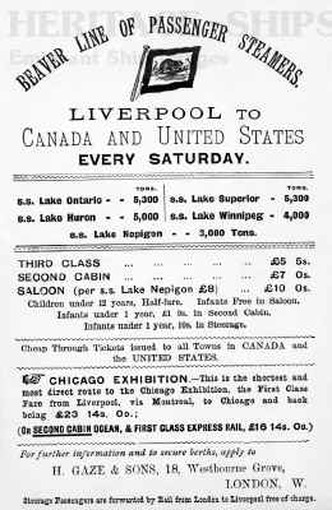Appendix II
The Flag of the Beaver Line
The Canada Shipping Company of Montreal was founded in 1867. The financial panic of 1893 caused difficulties for transatlantic shipping forcing the company to go into liquidation in 1894 and suspend sailing until the next year when it was placed under new management. In 1897 a new company called Beaver Line Associated Steamers was formed, but it also experienced financial problems and was taken over by Elder Dempster and Company in 1899 under the name Beaver Line of Steamers. The line was purchased by the Canadian Pacific Railway Company, so that the ship Lake Manitoba made its last voyage for the Beaver Line on 31 March 1903. The transition was symbolically signified on April 6 by hoisting the checkered white and red flag of the Canadian Pacific Railway on board the Lake Champlain in Liverpool (see fig. 1). [1]
Fig. 1. Below the checkered white and red house flag of the Canadian Pacific Railway appears the inscription “On Board S.S. Lake Manitoba September 3, 1904. The same flag flies from the mast of the ship. Less than two years earlier, the Lake Manitoba belonged to the Beaver Line and flew its flag featuring a beaver in centre (fig. 2). It is interesting that the flag of the Canadian Pacific Railway was white and red long before these colours became those of Canada in the mantling of its coat of arms granted in 1921 and particularly in its national flag adopted in 1965. The mantling is the convoluted drapery flowing from the helmet on both sides of the shield.
David R.P. Guay describes the Beaver Line flag as follows: “White with a blue border and a black beaver in centre.” [2] These colours are confirmed by Robert Finch who reproduces a sketch of the flag with the letters n/w B which for vexillologists mean black over white for the beaver and field and blue for the border. [3] I have found four depictions of the Beaver line flag all of which are black and white illustrations. The one in Guay’s work (p. 20) shows the beaver on what appears to be a log sprouting a shoot with three leaves near the head of the beaver that is facing the flagpole. A scroll below the flag bears the inscription BEAVER LINE. The original is probably in colour as it is a piece of Cauldon china and emblems are usually in colour on armorial china. The sketch accompanying Finch’s article shows the beaver facing the flagpole on a log with a branch at each extremity. A reproduction in Elizabeth Collard’s work is from “a plate made for Montreal’s Canada Shipping Company.” The beaver faces the flagpole and is in on a log with branches at each extremity. The whole is within a garter inscribed “CANADA SHIPPING COMPANY, MONTREAL.” A scroll below is inscribed “BEAVER LINE OF STEAMERS” [4] which dates the plate between 1899 and 1903. Since this badge-like depiction is on a ceramic plate, it is likely in colour, but the location of the piece is not mentioned. The last flag I have found is on a Beaver Line advertisement for passenger steamers from Liverpool to Canada and the United States (fig. 2). The beaver appears to be on a log with branches at each extremity, but unlike the other depictions, the animal faces away from the flagpole.
Fig. 2. This Beaver Line advertisement for passenger steamers from Liverpool to Canada and the United States displays the flag of the Beaver Line. The advertisement mentions the Chicago Exhibition, namely the Chicago World’s Columbian Exhibition which lasted from 1 May to 30 October 1893. It is reproduced with the kind permission of Norway Heritage (www.norwayheritage.com) which allows the reproduction of images from its collection for non-profit purposes.
Notes
[1] David R.P. Guay, Passenger and Merchant Ships of the Grand Trunk Pacific and Canadian Northern Railways (Toronto: Dundurn, 2016), p. 20.
[2] Ibid., p. 263.
[3] Robert Finch, “Silent Parables,” 3, no.1 (issue 9, Spring 1988), p. 13.
[4] Elizabeth Collard, Nineteenth-Century Pottery and Porcelain in Canada, 2nd ed. (Montreal and Kingston: McGill-Queen’s University Press, 1984), p. 238.
[1] David R.P. Guay, Passenger and Merchant Ships of the Grand Trunk Pacific and Canadian Northern Railways (Toronto: Dundurn, 2016), p. 20.
[2] Ibid., p. 263.
[3] Robert Finch, “Silent Parables,” 3, no.1 (issue 9, Spring 1988), p. 13.
[4] Elizabeth Collard, Nineteenth-Century Pottery and Porcelain in Canada, 2nd ed. (Montreal and Kingston: McGill-Queen’s University Press, 1984), p. 238.



